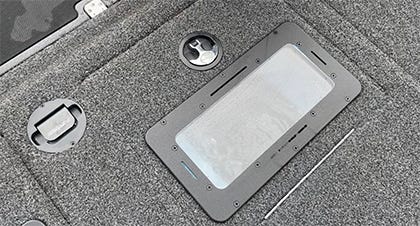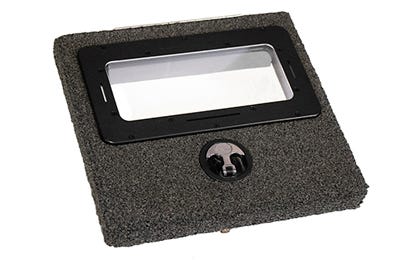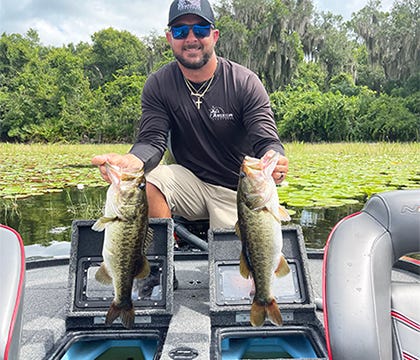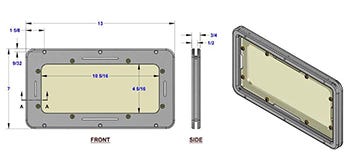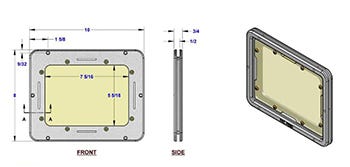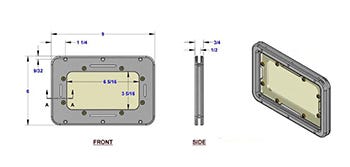

It’s a bass tournament angler’s nightmare: open the livewell lid to find the precious cargo inside — which might be worth thousands of dollars — belly up. It doesn’t happen often, but when it does the consequences can be huge.
Contents
Refining a Livewell Viewport for Bass Boats
Most tournaments impose a significant penalty for dead fish brought to the scales and, of course, prohibit culling dead fish. (“Culling” means swapping out smaller fish caught earlier in the day for larger ones caught subsequently, in order to put together the largest five-fish bag.) Even aside from the tournament implications, no competitive bass angler wants to kill a fish.
Even aside from the tournament implications, no competitive bass angler wants to kill a fish.
Fish die in livewells for a variety of reasons. Sometimes they’ve been hooked too deeply. Sometimes the water in the well gets too warm. Sometimes it’s not oxygenated enough. Sometimes a pump or plumbing connection fails. Sometimes somebody forgets to put the plug in or close the drain.
Early Detection is Key
With the exception of injured fish, all of these are readily fixable issues — provided they’re discovered in time. A too-hot livewell can be cooled down with a couple of frozen water bottles. If an aerator goes out, many boats have backup systems. Otherwise, an oxygenating tablet can save the day. Failed pumps can be replaced, plumbing connections can be repaired and open drains can obviously be closed.
The key, again, is early detection — which is why tournament bass anglers compulsively check their livewells, sometimes dozens of times in a day of fishing, lifting the lid quickly to make sure the water level is right, the pumps are running and there are no whitish bellies or sides visible. It only takes a few seconds to see that everything is in order, but add the time it takes to get from the bow to the well and kneel to open the lid, and then multiply that by a couple dozen round trips a day, and it adds up to quite a few lost casts.
Material Matters
That’s the problem that Donnie Ewers, a Sales Engineer at Boat Outfitters and an amateur tournament bass angler, thought he might be able to solve with a small, transparent window that could be retrofitted to a livewell lid.
The idea itself was hardly revolutionary. A viewport in the livewell lid, after all, is a simple solution to a simple problem, allowing an angler to check water level and circulation and make sure no fish are belly-up with a quick glance from almost anywhere in the boat.
The challenge was implementing it. It had to be low-profile enough to not create a tripping hazard and yet strong enough to stand on. It had to be large enough to give an angler a good view but small enough that bass inside still had shade to lie in. And of course it couldn’t significantly heat the water in the well and couldn’t fog up in the sun. Ultimately, it was a matter of finding the right material, which wasn’t easy.
Refining an Idea
The first time Ewers took his boat out with a prototype viewport installed, his primary concern was heat. He took a thermometer to measure and record the water temperature in the well with the viewport, a second well without a viewport, and the lake every hour from 6 a.m. to 3 p.m., a typical tournament day.
Almost immediately, though, the viewport fogged over to the point it was essentially useless. Clearly, some kind of anti-fog coating was needed. Still, Ewers recorded temperatures throughout the day and found that the livewell with the viewport was one to three degrees warmer than the well without. Surprisingly, though, the ambient temperature of the lake tracked with the temperature of the well with the viewport. The well without the viewport was actually slightly cooler than the lake water.
Finalizing the Perfect Material
Encouraged that heating didn’t appear to be a major issue, Ewers and the Boat Outfitters team started experimenting with different combinations of clear sheeting material and anti-fog treatments.
They settled on a tough, clear sheeting material that blocked UV and infrared light to reduce heat buildup, but finding a compatible and effective anti-fog coating was harder. Some treatments worked well but didn’t adhere sufficiently. Others were films that peeled off or tore during machining. After testing numerous samples from multiple suppliers, the team identified a coating applied by dipping that lasted well, resisted fogging and protected against scratches.
A carefully engineered frame made from CNC-milled King Starboard allowed the viewport to rise only 1/4” above the mounting surface — and less than that above the carpet found on a typical bass boat livewell lid. As a final touch, vents were added to the frame to promote air circulation, further decreasing fogging and allowing heat and metabolic gases to escape.
An Added Benefit
After fishing with a series of prototype viewports, Ewers believes they provide an additional advantage beyond the obvious plus of being able to check livewell status at a glance. Conventional wisdom holds that bass stay calmer and healthier in a dark livewell than when exposed to light. After all, when a livewell lid is opened, suddenly letting the sunlight in, the bass inside seem to panic.
Ewers, though, believes their agitation isn’t due to the light itself but rather to the sudden transition from dark to light. With viewports on his livewells, he says, the fish do seek out the shade along the sides, but don’t show nearly as much stress when the lid is opened. So using the viewport to check livewell status instead of opening the lid multiple times a day saves the fish considerable stress.
Compatability & Availability
Boat Outfitters currently offers the livewell viewport in 3 sizes: 10” x 8”, 13” x 7”, 9” x 6”. The viewport is installed with #8-32 flathead machine screws and can be mounted in an existing lid making it a great retrofit project for existing boats. Although this viewport was designed to fit a bass boat livewell, it can be used on applications beyond the bass boat community.

